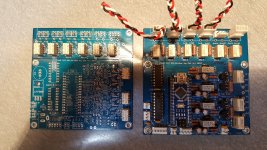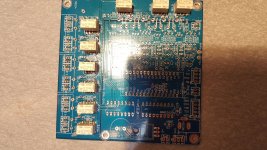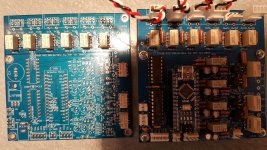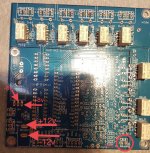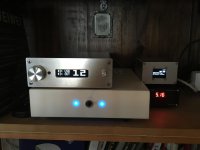Thanks Neb!
the extra size of the tuner case also allows me to put the crossover and my two Sub-Amps in there.
The Letters are not really that important, just a nice to have...
I wanted to use Kapital letters instead of the input number. like PC,BT,
I also tried to include Fonts from the Adafruit_GFX.h Library, but thats above my skill level with arduino.
Do you have an idea why my Display is not fading?
it always stays lit fully, i used your latest code for Oled_4x2s, the Display is same as the one you posted earlier in this thread. IDE is 1.6.9, but my board is not your newest V3, i got the "previous" Rev.
You put an amzing amout of work into this!
Thanks again for all your help!
J
You might have a slightly different display hardware. I am using the one from wide.hk.
Thanks for giving me directions,
after updating my libraries with the ones from your Drive it works fine.
🙂
after updating my libraries with the ones from your Drive it works fine.
🙂
zdr,
Just looking at the differences between the v2.2z and the v2.5s 4x2 board I just received. It should be possible to ignore the new onboard PS positions and power it with the same external PS board as v2.2z, correct?
Just looking at the differences between the v2.2z and the v2.5s 4x2 board I just received. It should be possible to ignore the new onboard PS positions and power it with the same external PS board as v2.2z, correct?
I don’t recommend single power supply, ldr resistance is very sensitive to supply voltage variations.
I wasn't planning on using any of the PS components on v2.5s if possible. I just want to make sure that I can use it with the same components that I did on v2.2z and have all regulation on the PS board.
I haven't tried to follow all the new traces but it looks like I can use the same power connectors on v2.5s that I did on v2.2z and leave the regulator and filtering positions empty. Just trying to verify that.
I haven't tried to follow all the new traces but it looks like I can use the same power connectors on v2.5s that I did on v2.2z and leave the regulator and filtering positions empty. Just trying to verify that.
New pcb is backwards compatible. You just leave out regulator and capacitor and use the power connectors as usual.
Hi zdr,
Are you still selling LDR kits or just AIO PCBs?
I would be very interested in buying one.
Cheers,
xbitwise
Are you still selling LDR kits or just AIO PCBs?
I would be very interested in buying one.
Cheers,
xbitwise
Working well
Hi, a quick note to report back on my experience after a couple of weeks with the VxD volume controller v 2.6 in my main system.
Output is to Peter Daniel Gainclone amplifier, input is from a Allo Kali / Piano2.1 DAC fed by a 320 kbs Spotify stream. Speakers are KEF LS50's.
Safe to say that the sound I'm getting from this set-up is the best I have been able to obtain so far. It is very airy and transparent with silky tight deep bass and beautiful rendition of instruments and voices. I can listen for hours on end working or doing other things and really liking the enveloping effect of the music. When sitting close to the speakers (they are monitors after all), its almost like having a pair of very good headphones on and the spaciousness of the sound is fantastic.
The user interface, remote control and calibration of the LDR's are also very cool.
So, thank you to all involved (especially Neb) in the creation, tuning and optimisation of this great volume controller 🙂
Hi, a quick note to report back on my experience after a couple of weeks with the VxD volume controller v 2.6 in my main system.
Output is to Peter Daniel Gainclone amplifier, input is from a Allo Kali / Piano2.1 DAC fed by a 320 kbs Spotify stream. Speakers are KEF LS50's.
Safe to say that the sound I'm getting from this set-up is the best I have been able to obtain so far. It is very airy and transparent with silky tight deep bass and beautiful rendition of instruments and voices. I can listen for hours on end working or doing other things and really liking the enveloping effect of the music. When sitting close to the speakers (they are monitors after all), its almost like having a pair of very good headphones on and the spaciousness of the sound is fantastic.
The user interface, remote control and calibration of the LDR's are also very cool.
So, thank you to all involved (especially Neb) in the creation, tuning and optimisation of this great volume controller 🙂
Attachments
Last edited:
Very glad you like it. You should move to the next level and replace gainclone with Roender’s FC100.
Looks like an interesting project but I’ll enjoy the absence of updatonitice for a while longer 🙂 it’s feels so good !!!
Does this amp use a lot of electricity when idle / running ? I've tried to avoid amps that heat the room while idle 🙂
Last edited:
i mean the FC100
RMI-FC100 is class A until 8W so there is some heat dissipated, but it can be biased for less dissipation. Better to ask for details in the FC100 thread.
zdr,
Purchased your v2.2z version board recently and tried hooking it up today. I am getting a error 20. According to the trouble shooting section, this is related to the power supply voltages. After double checking that the proper voltages are getting to the controller board connectors, I was wondering if I might have missed a jumper on this new board that incorporates locations for it's own power supply components?
Is that the problem or is there anything else I should be looking for?
Regards,
Roy
Purchased your v2.2z version board recently and tried hooking it up today. I am getting a error 20. According to the trouble shooting section, this is related to the power supply voltages. After double checking that the proper voltages are getting to the controller board connectors, I was wondering if I might have missed a jumper on this new board that incorporates locations for it's own power supply components?
Is that the problem or is there anything else I should be looking for?
Regards,
Roy
There are no jumpers to be set, board is backwards compatible out of the box. Error 20 means relay power failure or ldr failure (resistance > 200 ohm)
- Home
- Source & Line
- Analog Line Level
- Arduino based LDR volume and source selection controller
